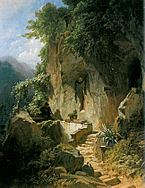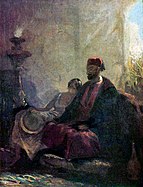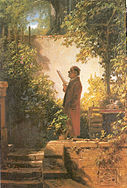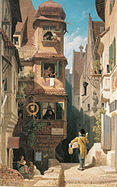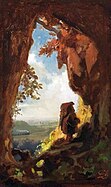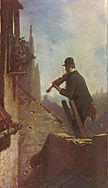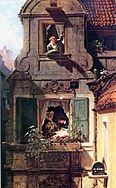Carl Spitzweg
You can help expand this article with text translated from the corresponding article in German. (September 2020) Click [show] for important translation instructions.
|
Carl Spitzweg | |
|---|---|
 Carl Spitzweg in a photograph taken c. 1860 | |
| Born | February 5, 1808 |
| Died | September 23, 1885 (aged 77) |
| Nationality | German |
| Known for | Painter, poet, artist |
| Movement | German Romanticism, Biedermeier |
| Signature | |
 | |
Carl Spitzweg (February 5, 1808 – September 23, 1885) was a German romantic painter, especially of genre subjects. He is considered to be one of the most important artists of the Biedermeier era.
Life and career
Spitzweg was born in
Spitzweg was self-taught as an artist, starting out by copying the works of Flemish masters. He contributed his first work to satiric magazines. Upon receiving an inheritance in 1833, he was able to dedicate himself to painting.
Later, Spitzweg visited European art centers in
His paintings inspired the musical comedy Das kleine Hofkonzert by Edmund Nick.
Spitzweg is buried in the Alter Südfriedhof in Munich.[2]
Forgeries
In the late 1930s an art forgery case in Germany involved 54 paintings which had been passed off as Spitzweg originals. They had been painted by a Traunstein copyist named Toni, who worked from reproductions and picture postcards. Toni signed the works "in the style of Spitzweg" with his own name, but fraudsters later removed his name and artificially aged the paintings in order to sell them as originals. At the Stuttgart Criminal Court Assizes, the conspirators were jailed for up to ten years for the swindle.[3]
Looted works
Adolf Hitler was a fan of Spitzweg's work; he claimed to have acquired the world's finest collection of Spitzwegs.[4]
Playing Piano, an etching by Spitzweg, was found as part of the Munich Art Hoard.[5][6]
Selected paintings
-
The Bookworm, original 1850, Museum Georg Schäfer. Two other versions exist.
-
Music-making Hermit before his Rocky Abode, c. 1856–1858
-
The Eye of the Law (Justitia), 1857
-
In the Harem, after 1855, Museum Georg Schäfer
-
The Poor Poet, 1839, Neue Pinakothek
-
Newspaper reader in his backyard, c. 1845–1858
-
The butterfly hunter, 1840, a depiction from the era of butterfly collection
-
The Letter Carrier in the Rose Valley, c. 1858–18
-
Gnome Watching Railway Train, c. 1848
-
The Attic, c. 1840s
-
The Hermit Asleep
-
The Painter in a Forest Clearing, Lying under an Umbrella, c. 1850
-
Arrival of the Stagecoach, c. 1859
-
The Serenade, 1854
-
The Intercepted Love Letter, c. 1860
-
In the Alpine High Valley (Landscape with Mt. Wendelstein), c. 1871
References
- ^ Jensen, Jens Christian (2002). Karl Spitzweg, Museum Georg Schäfer. Prestel. p. 342.
- ^ "Carl Spitzweg | German painter | Britannica". www.britannica.com. Retrieved 2022-08-09.
- ^ Schuller, Sepp. (1960) Forgers, Dealers, Experts: Adventures in the Twilight of Art Forgery. Translated from the German by James Cleugh. London: Arthur Barker, p. 93.
- ^ Frederic Spotts: "Hitler and the Power of Aesthetics". Pg 194, 218.
- ^ "Photo Gallery: Munich Nazi Art Stash Revealed". Spiegel. November 17, 2013. Retrieved November 17, 2013.
- ISSN 0362-4331. Retrieved 2022-08-09.
Sources
- ISBN 0-14-051300-0.
External links
 Media related to Carl Spitzweg at Wikimedia Commons
Media related to Carl Spitzweg at Wikimedia Commons- Biography and selected paintings of Carl Spitzweg
- The Spitzweg Game Archived 2004-01-12 at the Wayback Machine
- Spitzweg Gallery at MuseumSyndicate Archived 2012-11-24 at the Wayback Machine
- Milwaukee Art Museum has a large Spitzweg collection
- German masters of the nineteenth century: paintings and drawings from the Federal Republic of Germany, a full text exhibition catalog from The Metropolitan Museum of Art, which contains material on Carl Spitzweg (no. 87–90)


